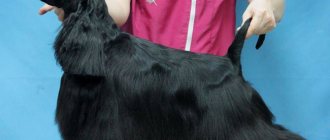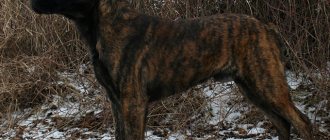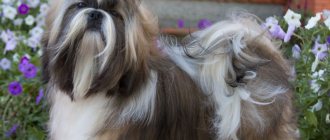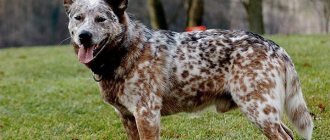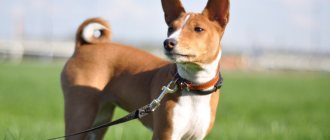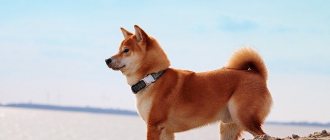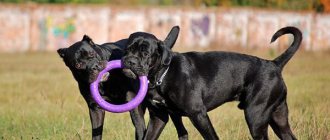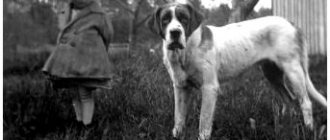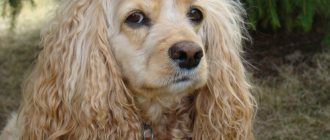Care and maintenance
Shorthaired Australian Heelers do not require grooming or any special care. Their wool has excellent self-cleaning properties and does not emit an unpleasant odor. Therefore, there is no need to bathe them, much less use various shampoos that will only harm them. If you are going to an exhibition, simply wipe your pet with a damp towel.
Female heelers shed twice a year. This coincides with estrus. In males, the shedding process occurs once a year. To keep the room free of hair, brush your pet as often as possible during these periods. And also do not forget that animals can periodically get fleas, and take timely measures to remove them.
Check your ears every one to two weeks and clean them if necessary. The Australian Heeler can be kept in a city apartment, but a private house would still be preferable for them. When kept in an apartment, heelers, like any working breed, need daily long walks twice a day, during which your pet can not only run, but also relieve itself.
It is better to keep your dog on a leash while walking and let it off only in designated walking areas. When bringing a heeler into a private home, build an enclosure and a comfortable booth for him.
But you can't keep your dog locked up all the time, and this breed is not meant to be chained.
Health and heredity
In a year, no more than three hundred representatives of the Lancashire Heeler breed are born in the world, whose puppies are mainly distributed throughout European countries. Keeping statistics of hereditary diseases for only 4 thousand breed individuals is a simple and easy task, especially since dogs have excellent health and a strong immune system.
Healers mainly suffer from eye diseases that are inherited:
- cataracts that appear in old age;
- dry keratoconjunctivitis;
- persistent pupillary membrane and choroid of the lens;
- glaucoma.
Dysplasia is extremely rare, but patellar luxation is common and even young dogs are susceptible to it. Malocclusion is common. In old age, bitches need to be regularly seen by a veterinarian to avoid the occurrence of pyometra, and the temperature of an older dog should be regularly measured.
Seasonal preventive treatments for dogs against fleas, ticks and mosquitoes are very important. A bite from an infected parasite can cause serious illnesses that are incompatible with the life of the animal.
Maintenance and care
The ideal home for keeping such a pet is a country house. If desired, the dog can be kept in an apartment, however, subject to constant activity. If the owner plays sports or likes to travel, the dog will be happy to keep him company.
Australians shed twice a year, males - once. The rest of the time there are no problems with the coat, the main thing is to comb them every day. During the molting period - more often.
You should wash your pet as soon as it gets dirty.
It is important to note that they rarely get dirty, since wool has a self-cleaning effect. You can also clean the coat using dry shampoo, which is less destructive to the animal’s natural defenses.
Due to heavy physical activity, paw pads are susceptible to injury and abrasion, so they need to be periodically lubricated with special oil. The claws usually wear off on their own; if this does not happen, they need to be trimmed.
Eye care is quite simple; they are washed with chamomile decoction or a special lotion. Ears are cleaned once a week.
It is advisable to feed your pet natural food or good industrial food from the super premium line. When choosing a natural diet, the basis of the diet should be meat and meat and bone components; cereals, fresh vegetables and fruits should also be added to the food. Several times a month - fish and dairy products. Dry food is selected according to weight category and breed.
Stone fruits, sweets, long bones, fatty meats, salt and spices should not be given.
Pet diet
The Lancashire Heeler is very unpretentious in nutrition. He can eat both ready-made food from the manufacturer and regular food.
Depending on the general condition of the pet, when feeding natural products, it is worth periodically adding vitamin supplements. "premium" "super-premium"
In any case, no matter what type of food you choose, you should never forget about the presence of fresh vegetables and fruits in your pet’s daily diet. It is best if these products are seasonal.
To replenish nutrients, it would not hurt for a Lancashire to take vitamin complexes, because with all its energy, it is natural that a lean body requires an increased amount of vitamins and microelements.
Features of character and behavior
The Australian Cattle Dog is a breed that has endless energy. The activity in action is simply incredible. It is not surprising that for the shepherds on the Australian continent, there was no better friend and helper. The ability to independently monitor the herd and make instant decisions has been recommended as the best working breed.
Advantages
The advantages of the Australian Heeler include:
- Intelligence – the breed is positioned as one of the smartest and is included in the top 10 in the world.
- Pets are very affectionate and gentle towards their owner. They try in every possible way to please, to do everything right, in order to receive praise in return.
- They respond well to training. Thanks to their innate organizational abilities and mental development, dogs achieve good results, which are assessed with the highest scores at competitions and exhibitions.
- They love children. The main criterion of Australian breeders when breeding the breed is based on the fact that the heeler must get along and treat children with care. If contact is not established, mating is prohibited.
- Curiosity and sense of humor. The dog will be delighted if he sees something that can make his owner laugh or please. Curiosity manifests itself constantly, this is facilitated by innate mobility.
- Dimensions and health. The object does not belong to the category of large dogs, transportation will not cause inconvenience. The breed is famous for its strength and excellent health.
- There are no whims with food. A working dog, he will eat what he gives.
Training
Since the healer has a heightened sense of protection, such dogs will be indispensable as a guard. By nature they are non-aggressive, but they are distrustful and wary of strangers. The dog experiences endless love for its owner and good nature for other family members and relatives. Heelers do not get along with other pets.
Expert opinion
Anna Abramenko
An avid dog lover. Experience in veterinary medicine since 2009.
Ask a Question
Breeders are advised to train the Australian Cattle Dog from childhood. The dog must understand that the owner is the leader. If you give an animal freedom, predicting its future behavior will be problematic. In the absence of education, healers often show not only disobedience, but can even periodically bite people on the legs.
Since the dog is highly intelligent, it is easy to train and quickly remembers commands. At the same time, he learns with enthusiasm. Heelers are used not only as farmer's assistants, but also as guards and rescuers. If there is no experience in training, the owner is recommended to send the dog to a professional dog training center, where it will quickly be taught basic commands. During training, it is strictly forbidden to use force or raise your voice at the puppy.
On a note! Heelers are not recommended for families with children, since the dog will mistake the baby for an animal from the herd and try to coordinate its movements.
Qualities and character of dogs
The main purpose of dogs was to protect estates and livestock, so a large, hardy, courageous dog with good guard qualities and the ability to chase and fight a predator was needed. Previously, shepherd dogs were used for this craft, and then a whole list of breeds was determined.
The guarding and hunting qualities of the dog are important for the shepherd. So that while grazing in places where wild birds gather, the dog could bring prey and raise the bird on its wing for hunting.
The pet must have thick and warm fur so as not to freeze in bad weather. Unquestioning obedience, discipline and balance are mandatory requirements for a “guard”.
History of the Lancashire Heeler breed
The homeland of Lancashire Heelers is clearly stated in the breed standard - Great Britain.
Archaeological research carried out in the British Isles has made it possible to find multiple images of dogs similar in build and color to Lancashire dogs.
Examples of dogs similar in appearance to modern Lancashires were more often found in Lancashire, where these dogs got their nickname.
There is reason to believe that the blood of Welsh Heelers, Cardigan Welsh Corgis, Pembroke Welsh Corgis, Spitz and Manchester Terriers is mixed in the veins of Lancashires.
Targeted selection work with this breed of dogs was not carried out until the mid-1960s, when several enthusiasts, due to the threat of extinction, came up with the idea of restoring the Lancashire Heeler breed.
During the selection process, Manchester Terriers were crossed with Welsh Corgi Cardigans to produce puppies of a new breed that inherited many positive qualities (including herding) of their ancestors.
Photo 1. Lancashire heelers have a dense, well-built, muscular build
The resulting offspring were again crossed with each other, the “defective” specimens were sifted out, thanks to which it was possible to create a breed that is now commonly called the Lancashire Heeler.
In 1978, the first kennel club was created, uniting lovers of Lancashire heelers, and three years later the first breed standard was developed.
The English Kennel Club recognized the new breed in 1981, and the International Canine Federation recognized it another 35 years later (in May 2016).
The official participation of Lancashire heelers in authoritative exhibitions was recorded in 1984.
In 1988, a stud book of Lancashire Heelers was created, which included data on seven and a half hundred purebred representatives of this breed.
The baton of mass breeding of Lancashire heelers was actively picked up by breeders from Scandinavia, Belgium, Holland, and the USA.
In 1989, the Swedish Lancashire Heelers Club was registered, in 2003, a similar club was registered in Finland, and in 2010, Norway.
It is in these countries that the largest number of purebred Lancashires outside the UK is concentrated.
Lancashire Heelers are capable of producing from 2 to 4 puppies per year, which is why it is not possible to quickly increase the number of dogs of this breed.
Around the world, about three hundred Lancashire Heeler puppies are born each year. In total, there are just over 4 thousand individuals of Lancashire.
There are practically no purebred Lancashires in Russia, since Russian nurseries are not yet involved in breeding them.
Rare representatives of this breed are registered in Moscow and the Moscow region; they are counted in just a few.
Kinds
Since the breed is still in the development stage, there are different types of specimens among it. The main differences are in the color and structure of the coat. However, it is not distinguished by variety. Rather, it can be divided into several types according to use:
- shepherds and beaters;
- hunters and watchmen;
- companions and assistants who are always nearby, at your feet (actually “heeler” can be translated from one of the English slangs as “henpecked”),
- sporting dogs;
- rescue dogs.
All these qualities, in fact, can be inherent in the same dog. We can say that the Lancashire Heeler is a universal dog. Closest relatives are Welsh Corgis (Welsh Corgis) and Manchester Terriers. A few words about these breeds.
Welsh Corgis (Pembroke and Cardigan) - according to Welsh legend, these dogs were a gift to humanity from fairies, because people supported them in their conflict with greedy gnomes. Dogs have darker colored fur on their backs, like a saddle, which was used by the winged fairies who chose these animals to travel.
Legendary shepherd dogs look a bit like fox cubs, with lots of light red, smooth fur combined with soft white fur. Three colors are also allowed within the breed - red-white-black, just black (rarely) and brindle colors. White markings are possible with any color.
Short legs, erect ears, squat long body, medium-length tail and very attentive brown eyes. This charming dog has an ancient pedigree, belongs to the Shepherd Dogs, and is truly considered a royal breed. In the early 30s of the last century, Queen Elizabeth II of England received a representative of this breed as a gift from her father.
Manchester Terriers are also a British dog breed, developed in the early 19th century. It owes its appearance to the struggle of the British against unsanitary conditions at that time, in particular, against the rats that infested the country. The fighting and swift dog successfully coped with its task. His tenacious grip and strong jaws allowed him to practically tear his victim in two.
Their size did not exceed 40 cm, weight was about 5-8 kg. The British carried a small hunter with them in special leather bags. The coat is smooth, black and tan in color, the ears are usually half-dropped, but erect when tense.
One of the oldest official terrier breeds. The Lancashire Heeler in the photo may remind someone of a Welsh Corgi, but a connoisseur will immediately see the differences. The Lancashire is distinguished by its smaller size, higher paws and rounded head shape.
Types of herding breeds
Each region uses its own national herding dogs to guard the herd. There are many varieties, but the purpose is the same - to protect the herd from attacks by predators and to help the shepherd drive the cattle to the field.
Initially, this craft used bloodthirsty, fearless dogs of enormous size, ready to fight wild predators and even bears. But the years passed, the world improved, wolves and foxes were shot, which made grazing easier and safer. Shepherd dogs have become smaller in size, and their character has become more loyal to others. Let's look at the most common types of herding dogs.
Scottish collies
The breed originates from Scotland, where it is valued for its loyalty and love for its family. An excellent loyal friend and assistant, she has a high mind and intelligence, she is characterized by responsiveness and compassion, affection, and courage. Despite the herding type, the collie is a welcome friend in every family. She is easy to train, disciplined and smart, loves children and is ready to stand up for her family no matter what.
Top articles: What do cats like?
The Scottish shepherd dog became very popular in the 50s after the release of the film "Lassie", which showed a real collie, brave, smart, loyal and loving.
Collie height is 65 cm, and weight is up to 35 kg. The breed is characterized by long, thick red-and-white fur. They tend to lead an active lifestyle: they love to play, run, bark and chase moving cars. They are participants in many contests and competitions, but at the peak of their fame, unscrupulous breeders were engaged in breeding puppies, so their purebredness weakened.
When buying a puppy, you need to pay great attention to its gender and get acquainted with the documents of the parents. It is better to buy from a breeder with a good reputation, who values his name and sells quality puppies
The cost ranges from 20 to 50 thousand rubles.
Border Collie
An incomparable shepherd dog, one might say, one of the best. The Border quickly learns commands and is very smart, which sets it apart from other breeds. The origin comes from England, or more precisely, from the border area between England and Scotland. Historical data indicates the emergence of the Border family as early as 1570.
A graceful, slender, but at the same time strong and strong dog. The coat is short and medium length, there is an undercoat, thanks to which it does not freeze in cold weather. Outwardly not as beautiful as a collie, but quite smart. By nature, the dogs are very smart, balanced, easy to learn and trainable.
The English Cattle Dog is an excellent herder. She can independently graze the herd, knowing each sheep by smell, controls the process of pasture and the location of the herd in the field, preventing predators and strangers. You will have to pay a lot for a border puppy: their cost is 25,000-50,000 rubles.
Australian Cattle Dog - Heeler
The heeler was bred in Australia for driving sheep and cows over long distances. To breed extremely hardy “shepherds,” short-haired collies and wild dingoes were used. As a result of selection, a new type of pet was developed, capable of very long walks, hardy, smart, flexible, strong, brave, but a little stubborn.
The dogs are easy to train, smart, strong, with a muscular build, very active, but despite this, affectionate, loyal and loving, ready to defend the family in any situation. Their population around the world is growing every day.
Bernese Mountain Dog or Bernese Shepherd
Another type of four-legged shepherd is the Swiss Shepherd. The roots of the breed grow from the city of Bern, hence the name - Bernese Mountain Dog. Pets make you fall in love at first sight with their beautiful appearance, aristocratic behavior and manners; four-legged animals often appear in films and are wildly popular as pets.
By nature, representatives of the family are calm, good-natured, affectionate, balanced, do not show aggression towards other pets and strangers, but are ready to become excellent guards and protectors of the family. They tend to be peaceful, so in suspicious situations they bark and growl loudly, but rarely attack. Amenable to training and strict discipline.
Mating
Mating must be taken very seriously in order to get healthy offspring:
- Before the procedure, be examined by a veterinarian and take genetic tests. Unfortunately, if the dog is a carrier and especially a carrier of a disease that will affect the offspring, mating is prohibited. Various crossing options are considered when there is a high probability of the birth of healthy puppies. The breeders are responsible in each case.
- Heelers that have reached 1.5 years of age are considered sexually mature. Bitches go into heat in the autumn and spring. It is customary for owners to breed a pair on the 2nd or 3rd heat and 8–10 days after the start.
- Mating takes place traditionally in the territory of the male. If the male does not recognize the female and shows aggression, the procedure is repeated every other day. The best time of day for mating is morning.
- After proper mating and three months of gestation, puppies appear. The quantitative component of the litter is 1 – 7 pieces.
Feeding
There are no special features in feeding . There are no separate foods available for this breed, and therefore purchased food must be selected according to other criteria: obesity, if the dog is sterilized, likes to beg, or regular dog food. But it is better to give preference to high-quality feed, they are much better digestible, healthier and almost never have contraindications.
Simple homemade feeding foods are also suitable. The diet usually includes porridge, some kind of meat, bones, and vegetables. As with other dogs, you should not feed your pet sweet or fatty foods. Ideally, meals should be complete, healthy and divided into 2-3 meals a day.
Breed Features
This dog's appearance is quite bright - the animal cannot be confused with any other. That is why most first meetings with representatives of this breed end in the person’s boundless love for this dog. Let's take a closer look at what makes this animal fall in love with it.
Did you know? Dogs are able to remember about 250 commands, which are expressed using all kinds of gestures or sounds.
Appearance and photo
- Life expectancy: about 15 years.
- Group: herding dogs.
- Who recognizes the breed: CKC, FCI, AKC, UKC, ANKC, NKC, NZKC, APRI, ACR.
- Coat color: dark blue or red; some individuals have a characteristic small white spot on the forehead.
- Coat length: medium.
- Shedding: moderate.
- Height at withers: 43-51 cm.
- Weight: 14-16 kg.
- Country: Australia.
According to the official description of the breed, the Australian Cattle Dog is an animal with a powerful and muscular build. Despite their sluggishness and, at first glance, clumsiness, individuals of the breed are distinguished by good dexterity and agility, with which the dog manages to impress quite a lot of people. The length of the animal’s body exceeds its height; any other general body shape automatically indicates that the dog is not purebred.
The main features of the appearance of a heeler, which characterize the individual’s belonging to a purebred breed:
- hanging tail;
- the front legs are perfectly straight, without any irregularities;
- the head is wide, its shape tends to ideal roundness, the muzzle is large;
- the ears are set wide apart, the tips are pointed, and fur grows on the inside of the ears;
- eyes are small, oval, brown in color;
- powerful jaws, scissor bite;
- exclusively black color of the nose;
- the neck is powerful and muscular, the back is straight;
- The chest is wide, the ribs stand out perfectly on the body;
- the paws are round, the claws are strongly curved.
Did you know? Unlike popular opinion, dogs do not like to be hugged or stroked on the head; for the animal, these gestures are regarded as a sign of obvious dominance.
Character and psychology of a dog
Initially, this breed was bred for the purpose of herding livestock and protecting it from predators, so the dog is distinguished by endurance and high mental abilities. This is a watchdog, so cowardice is unusual for him. In the most critical situations, the animal is ready to lay down its life so that the protected object remains completely intact and safe. In addition, over time, these animals have shown themselves to be devoted and faithful pets, so any individual can be taught and trained quite well.
But this dog is famous not only for its excellent working qualities. In addition to their strong and persistent character, dogs are distinguished by their good nature, affection and true love for people. These are loving and energetic dogs, capable of complete dedication for the sake of their owner. These qualities played a decisive role in turning this dog from a purely working breed into a family pet and one of the best companion dogs.
Also herding dogs include such breeds as: Alabai, Border Collie, Welsh Corgi, Caucasian Shepherd, Briard and Bernese Mountain Dog.
Important! The Australian Cattle Dog is not an animal for avid careerists; the dog requires constant attention and daily long walks in the fresh air.
Therefore, if you are unable to provide the animal with enough of your time, focus on another breed
Advantages and disadvantages
Healers have a good level of intelligence and are able to perceive, assimilate and carry out any commands. With good care and upbringing, they become more flexible and loyal. The dogs have a very high level of sociability and get along well with older children.
One of the advantages of dogs is their health. Dogs are not very prone to diseases. However, among the most common diseases in this breed, the following types are observed: primary lens luxation, cataracts, persistent pupillary membrane, collie eye anomaly, vitreous prolapse, myasthenia gravis, pyometra, cretaconjunctivitis sicca, glaucoma.
Dogs are quite sociable animals and do not like to be neglected. They show their dissatisfaction by taking out anger and resentment on various objects - chewed legs of tables and chairs, slippers, scattered objects.
Tell us about your experience of training a dog, about its relationships with people and other pets. We look forward to your feedback and comments.
Australian Heeler dog character
The blue heeler has a rather cunning disposition, and they spend a long time trying to test their owner’s strength.
It is important from the first days to show your pet which of you is more important. The breed was bred by man, and the healers are infinitely grateful to him for this, showing devotion and loyalty, and immediately to everyone who lives in the house
Children are especially fond of this breed. Breeders strictly monitor this, and if the dog shows hostility towards the child, then it does not take part in further breeding.
These dogs love to frolic. They almost always have a good mood and a great sense of humor. Very often you can see a semblance of a smile on their face. They are good-natured, although they have a slightly explosive character and can be unbalanced. Hillers do not get along well with other pets and are always trying to grab anything that moves.
Best articles: Tailless animals (frogs and toads)
Heelers are active and hardy, so they require long walks where they can run wild. And also from a young age, dogs need socialization and education so that they get used to others as early as possible, and they do not have the desire to bite passers-by on the legs. If you cannot devote enough time to your dog, then you should think about getting a calmer breed.
Choosing a puppy
It is best to choose a Lancashire in a nursery, where only the breeder can tell you the specifics of raising the pet and training. A big plus of the nursery is that you can see your dog’s parents, who can clearly show what it will look like when it’s more mature.
A true Lancashire Heeler must have a veterinary passport, a birth certificate and a brand, which he receives at the age of 45 days. All necessary vaccinations at the time of choosing a dog must be done and noted in the documents.
Australian Kelpie
The first breeder of the breed was supposedly Australian farmer Jack Gleason. He bought a dog named Kelpie from a Scottish friend, as the water spirit was called in Scottish folklore. After mating Kelpies with local dogs, puppies were born that quickly learned shepherding and skillfully managed flocks.
Targeted selection began in the mid-20th century at the leading Australian farm Enfinvale. In Russia, the best nursery operates in Stavropol.
Kelpies are compact, strong dogs up to 51 cm tall with a fox-like head and pointed straight ears. The coat is short and flat. Various colors:
- black;
- chocolate;
- pale yellow;
- ginger;
- blue.
Kelpies are willing to spend hours watching livestock. They control the sheep even without the shepherd's command. Puppies do not need special training. From the age of 2 months they learn everything on their own, repeating after their mother.
Kelpies have a wider viewing angle than other herding dogs, so they can cover and control a larger area with their gaze. They react instantly to the behavior of their students. To reach and rein in a disobedient sheep, they run freely right over the backs of the animals.
Kelpies obey one owner and treat family members kindly in order to please the owner. Dogs are famous for their athletic abilities. They often win in agility, freestyle, and Frisbee.
More than 100 thousand kelpies live in Australia; they are recognized by all leading cynological federations. In 2016, a kelpie named Maggie set a new record for life expectancy. She lived for 30 years.
Finland
- Bovenop (Marketta Lähdekorpi)
- Coppercoat´s (Krista Rantanen)
- Daamin (Anne Tanskanen)
- Heartbay's (Merja Huuskonen)
- Hightide's (Mervi Nousiainen)
- Kauhia Kartano (Teija Salomaa)
- Keep Loving (Natasha Murola)
- Kotisaaren (Kirsi Kotisaari)
- Liiterikoiran (Tuija Hatakka)
- Limespirit (Eeva Tuomisto)
- Lindkullas (Stina Nässling)
- Marmalade's (Anna Niiranen)
- Minimonsteri (Anna Kulmakorpi)
- Mustan Linnan (Tiina Hynninen)
- Myheels (Eeva Teräväinen)
- Peikkonevan (Katriina Neva)
- Pinpoint (Pia Markkanen)
- Pull Moon (Heta Hassel)
- Stalker (Riitta ja Pekka Hahto)
- Stallmästarens (Eva Stadius)
- Tarmonpesän (Tiina Siimekselä)
- Tsarodej (Riitta Ajanto)
Pros and cons of the breed
The advantages can be safely called good nature, love for children, affection and devotion. In addition, dogs have excellent intelligence and are easy to train. The disadvantage may be disobedience under certain conditions (improper upbringing, monotonous commands, keeping in an apartment).
Price of puppies
The price in Russia averages 40,000 rubles. The cost of an individual puppy may vary depending on gender, age, pedigree and vaccinations. It is best to buy such a dog in the summer, then the price for them drops significantly.
How to choose a puppy
The main factors when choosing an Australian Cattle puppy include the following: the presence of the necessary documents, the presence of a certain authority with the breeder, the puppy should not be from the first litter of the bitch. The puppy should have a healthy and strong appearance.
Nickname selection
For such active dogs of boys, the following nicknames are suitable: Addie, Aktai, Zhai, Kabai, Nabbi, Chaidi, Yumi. For girls: Bullet, Nami, Nika, Bertha, Amanda, Montana.
Price
The Lancashire Heeler is a rare breed not only in Russia, but also in the world. Buying a Lancashire dog puppy is not easy. But the most advanced domestic breeders, realizing the potential of this breed, have already imported producers from Britain and Scandinavia.
In addition to the rarity of the breed, there is another difficulty - there are few real heeler experts. Therefore, purchasing a purebred puppy is associated with the risk of receiving a fake. The price of a Lancashire Heeler is never low or even moderate, it can only be high. You need to focus on an amount approximately equal to 50,000 rubles.
There is an option that is even more expensive, but more reliable. It is enough to contact a foreign heeler nursery. Agree to purchase a puppy. Come and, after completing the necessary formalities, take the dog home. Heeler kennels are mainly located in England, but you can find breeders in Scandinavia.
Australian Heeler Health
The Australian Heeler is a strong, resilient dog, accustomed to life in difficult conditions. However, like any other breed, it has a genetic predisposition to certain diseases, which are listed below.
Having puppies undergo a medical examination in the first months of life helps prevent the spread of diseases in the family.
Most common diseases
The weaknesses of Australian heelers can be divided into three groups according to the most vulnerable part of the body:
ears
The most common ailment among Australian heelers is congenital deafness, which affects some blue-colored animals. There are also less radical options - partial deafness. According to statistics, every fourteenth healer hears in only one ear.
Early diagnosis of possible hearing problems is being actively implemented in many countries besides Australia
Within Australia, all heelers undergo a hearing aid examination at the age of one and a half months. This examination allows us to limit the number of dogs with deafness. Gradually other countries are coming to this method;
bite
Another genetic “flaw” of the Australian Heeler is the bite. Many representatives of the breed, despite well-developed jaws, experience a lack of teeth. Normally, an individual should have a set of 42 teeth, which is not so common.
Loss of teeth may make it impossible for a heeler to perform his duties as a herding dog.
If the dog is missing more than 3 pieces, the deviation is marked as defective. When buying puppies, it is advisable to get to know the jaws of the parents, since lack of teeth is inherited and progresses from generation to generation;
joints
The real Achilles heel of the Australian Heeler is the joints. In Australia, breeders manage to promptly eliminate individuals with joint dysplasia from breeding, while in Europe this defect is not monitored so strictly, and therefore is actively transmitted to offspring.
Joint problems are found in almost half of the individuals due to the carelessness of breeders
The situation continues to worsen - in Finland, almost half of registered healers are affected by this disease. Dysplasia usually affects overweight dogs, but with a hereditary predisposition it can also spread to fit, medium-sized dogs;
A predisposition to progressive blindness is also common among Australian healers. The reason for this fairly common defect is that, as a result of numerous mating options, the gene responsible for the atrophying retina has been fixed in this breed.
Unfortunately, loss of vision, especially in old age, is a common occurrence among healers
Typically, the first signs of blindness appear in an individual between 1 and 5 years of age. The symptoms appear rather mildly at first - the Australian Heeler begins to navigate worse in the dark and twilight. There is slight clumsiness, which was previously unusual for the dog.
A comprehensive puppy check will help you avoid encountering an incurable disease in the future.
The gradually atrophying retina of the eye can become a problem for many owners. If desired, you can conduct a genetic test that will determine the susceptibility of a particular individual to the disease. Dislocation of the lens of the eye, cataracts and other eye diseases are much less common.
Life expectancy of an Australian Heeler
On average, Australian dogs live up to 15 years. There are also excellent long-livers, reaching the age of twenty.
The longevity of a pet largely depends on the attentive attitude towards it from the owner.
Health and possible problems
- Primary lens luxation is a severe hereditary disease that causes blindness, especially in small dogs, which include Heelers. This occurs when the connecting fibers in the lens weaken and break, which has a very negative effect on the dog's vision until it becomes completely blind.
- Residual pupillary membrane is a condition of the eye that involves a portion of the embryonic membrane that persists as threads across the pupil and connects to the iris or cornea. This often causes cataracts,
- Dislocation of the kneecap (patella) is a very painful problem. Your dog will need to be taken to the vet for x-rays and a blood sample. Surgical intervention or regular reduction may be required - only a veterinarian will tell you specifically,
- Diabetes mellitus is also a common breed pathology. You need to check for symptoms, which include increased appetite, thirst, and increased trips to the toilet. Diabetes is a lifelong diagnosis, so you will have to provide the patient with constant insulin injections and regular nutritional monitoring,
- Cataracts occur in the lens of the eye and cause complete or partial clouding; this disease has an extremely negative effect on the animal’s vision. When it becomes complicated, if surgery is not performed, it can lead to complete blindness in some cases. In most cases, the hereditary factor plays a big role, but injuries, age-related changes, as well as the influence of other pathologies also play a big role,
- Collie eye anomaly is a genetic disease that affects the retina, sclera and choroid, which consequently leads to blindness,
- Glaucoma is another very common progressive eye disease that occurs when intraocular pressure increases and causes severe pain. In this case, the retinal cells are gradually destroyed, the fibers of the optic nerve depart, and visual impulses do not enter the brain. Glaucoma can be hereditary, but can also be caused by injury or tumors,
- Progressive retinal atrophy is a term meaning a large number of pathological processes that combine dystrophic degeneration of the retina, leading to vision loss. That is, to simplify, the retina loses the ability to perceive and process light. Most representatives of this lineage, faced with the problem of progressive retinal atrophy, first begin to experience problems with vision at night, and over time their vision will deteriorate significantly during normal lighting. Unfortunately, the problem currently has no cure and usually leads to complete blindness.
Nutrition for puppy and adult dog
According to the recommendations of dog breeders, it is better to feed the Australian Heeler with natural food. But there are several important points in this dog’s diet.
The presence of potatoes, bread, especially yeast and white bread, onions and garlic, spices, sugar and mushrooms in the diet is strictly prohibited. It is also necessary to completely exclude fatty pork, smoked meats, various sausages, sausages, chocolate, citrus fruits and dried fruits.
From cereals you can give oatmeal, rice and buckwheat, which should be only 40%. The remaining volume is filled with raw, lean meat (chicken, beef, turkey) or offal except liver. It needs to be boiled. A couple of times a week you can give your dog sea fish and boiled eggs. You can give your dog cooked vegetables, except those excluded.
Fermented milk products can be given daily to both a puppy and an adult dog. The exception is females in heat. These products often aggravate false pregnancy. Sometimes you can give apples and seasonal berries instead of treats. And don’t forget about natural mineral supplements such as kelp, seaweed, fish oil, spirulina, herbs and flaxseed oil.
Nutrition
Dogs are omnivorous creatures. Nutrition problems can be solved in two ways. In the first option, the emphasis is on industrial feed. This is convenient for the owner: no need to cook. This is good for the dog because it is guaranteed to receive a balanced diet.
Some owners believe that man's friend should eat specially prepared food. With this approach, the dog’s food must be fresh, contain the required amount of animal proteins, fiber, a minimum of fat, and the required amount of vitamins and microelements. The ratio of the main components is as follows:
- lean meat, any meat and/or offal (heart, liver, etc.) - from 40 to 60%;
- cereal, slightly or completely boiled - from 15 to 40%;
- raw or stewed vegetables - from 15 to 25%;
- fats and oil - very little, less than 1%;
- vitamin supplements are especially important when there is a shortage of fresh vegetables.
Origin story
The direct predecessor of the Australian Heeler is the indigenous breed of dingo dog. The name comes from the English heel, which means “heel”. Australian working herding dogs love to bite cattle on the legs while corralling the herd.
The breed was specially bred for driving large horned animals, grazing and protecting herds. The breed's breeder is Australian farmer Thomas Hall. The farmer wanted to get smart and hardy dogs for cattle breeding and decided to cross dingo and collie dogs.
For a long time, heelers lived only in the pastures of the famous breeder. But in 1870 the farmer died, his farm gradually fell into disrepair and was put up for auction. Under the terms of the sale, all real estate, as well as all farm animals, were transferred to the buyer. In 1876, a monument was erected to the creator of this amazing breed of dogs.
Several interested dog breeders and farmers began to further develop the breed. It is known that farmer Gerry Bagust took an active part in the development of the breed. In 1893, crossing Cattle Dogs with Australian Kelpies and Dalmatians was tested. The result was puppies of an interesting appearance, according to which in 1903, on the initiative of assistant Bagust, the first breed standard for Australian Cattle Dogs was created.
Best articles: The most unusual and exotic cat breeds - list, characteristics and photos
In 1945-1947, dogs began to be actively exported to the USA and Canada, where they became widespread. Following the Americans, Europeans became interested in heelers; in the 1980s, the first Cattle Dogs were brought to Great Britain. You can still see the development of the pedigrees of the original Australian heelers of the Landmaster Lenthal Flinton and Lenthal Darlot lines.
The first Australian dogs appeared in Russia only in 2004. The first puppy named D'astra Canina Diamantina was brought from Poland to Moscow; the first puppies from this bitch appeared only in 2011. Since 2010, the popularity of dogs has been gaining massive momentum; the number of purebred representatives of Australian shepherds in Russia today is about 200 individuals and continues to grow rapidly.
Brief characteristics of the breed representatives
The character of Australian Shepherd dogs is calm and friendly. Their content most often does not cause any particular difficulties. These pets are not fussy about feeding. They get along well with other animals and children.
Who are they suitable for?
Cynologists recommend getting an Australian dog for those who want a cheerful, energetic and active pet with whom they can spend their free time until sunset
The main thing is to be able to relax with your pet and give it your attention.
Who is better to choose: a male or a female?
If the male is castrated and the female is sterilized, there is practically no difference between them. This is due to the fact that such pets have approximately the same hormone levels.
If you choose an unsterilized female dog, you need to be prepared for the fact that she will go into heat every six months for 3 weeks. If you do not want puppies, the dog should be isolated during this period.
Can I keep it in an apartment?
Aussies require large areas to play and roam. That is why dog experts recommend that owners of country houses have such pets. However, you can also keep a dog in your apartment. You should be prepared for daily walks.
What is better to feed an Australian Shepherd: dry food or natural food?
The Australian Shepherd can be fed both dry food and natural food. Preference for one method or another should be given directly by the pet owner himself.
Dry food is distinguished by the absence of the need for pre-treatment, long shelf life and a balanced content of nutrients. Its main disadvantage is its significant cost.
As natural food, you can use meat, fish, dairy products, buckwheat, rice, oatmeal, vegetables, fruits and eggs.
Is it easy to train?
The Australian Shepherd Ossie is one of the breeds that is easy to train. She learns new commands very quickly and carries them out with pleasure if she approaches this activity correctly. For the training to be noticeably effective, it must be done regularly. The dog should exercise for as long a period of time as possible. At the same time, it is worth limiting agility exercises, and selecting complexes based on ingenuity.
How are Australian Shepherds used?
Currently, Australian Shepherds are used primarily in the United States. They help guard the herds of animals on the ranch. This breed is considered to be a good companion. Sometimes Australian dogs are used as utility dogs. They can help people with limited mobility navigate in space.
Grooming
The breed is easy to look after. It is enough to brush your pet regularly and wash it if necessary. During normal periods, you need to comb the animal 2-3 times a week; during shedding, this is done daily, otherwise the fur will roll into tangles and it will be impossible to remove them.
To comb out, you need a fine-toothed comb or a slicker brush; it is best to use a furminator. It is also necessary to monitor the length of the claws. Sometimes they do not grind off naturally, in which case they are trimmed with special nippers. This is done by the owner himself or you can contact a groomer.
For your information! Sometimes puppies have their ears glued to make them stand upright. This is done only by a specialist who understands how to fix the hearing organs.
You only need to bathe your pet when it gets dirty. For this purpose, special shampoos for dogs are used, as they have a gentle composition. To highlight the Aussie's red tricolor color, you can use conditioner.
Once a week, the pet’s mouth is cleaned with a special paste, this stops the development of tartar.
a brief description of
The Australian Heeler is a herding dog breed that is distinguished by its tirelessness, great endurance and high performance. This is a fearless protector, a loyal friend and a reliable life partner. If you decide to get such a pet, then be prepared for devotion and great love from your four-legged friend; you simply cannot find a better companion.
Heelers love children very much, they play with them with pleasure and protect them from trouble. These dogs are incredibly loyal to their owner; they quickly become attached to one person and feel sad if that person leaves for a long time. For Australians, loneliness is a real punishment, so if you are a busy person and constantly travel for work, it is better to choose a more stress-resistant pet.
Australian shepherds can easily be called the standard of devotion and fidelity. They will never leave their family in trouble, they will always be there and become a reliable shield in case of danger. Animals are endowed with a high level of intelligence, they clearly understand what is wanted from them, and are well trained and educated. However, due to their innate herding instinct, they often die under the wheels of cars, so it is best to keep such pets in rural areas. In addition, they need space, fresh air and the opportunity to do what they love.
Heelers are very mobile, active, love to play in nature, they are ideally suited for country life. Among other things, this is a very hardy and hard-working dog. If you have a farm in the form of a small herd, then she will be happy to take patronage over it.
Reproduction and lifespan
Breeding these dogs is best left to professionals, because the important factor of paperwork, as well as the nuances and difficulties of obtaining a purebred breed, can be difficult for a beginner. Therefore, trust experienced breeders and buy yourself a purebred puppy from trusted nurseries.
From the first days a puppy appears in the house, the owner is obliged to take care of its upbringing and socialization. The optimal age for this is 2-3 months
It is important to show your pet the world around him, other animals, including cats. It is necessary to train the puppy not to “herd” people - not to grab ankles, even when playing
Lancashire Heeler puppies need a dominant trainer because they are stubborn and intractable from childhood. It is through training and education that these qualities will be overcome. Just don’t use rudeness or violence against them.
Average life expectancy is 12-15 years. Diseases: Collie eye anomaly, dislocation of the primary lens (eye lens), persistent pupillary membranes. May suffer from a dislocated kneecap.
Description, appearance of the Australian Shepherd
The height of an adult Australian Shepherd does not exceed 56-58 cm. This breed received the status of a herding dog for its ability to very easily cope with herding a large herd or flock. Coat coloring can vary, but the most common variations are marbled red or marbled blue.
Breed standards
According to the FCI classification, the Australian Shepherd has very correct proportions, a slightly elongated body, medium size and the following standards:
- the head is clearly defined, strong and dry, proportional to the body, with a small occipital protuberance and a moderate or well-defined stop. The pigmentation of the nose and lips varies depending on the color of the coat and can be black or light brown. The presence of pink spots is allowed, the number of which should not exceed a quarter of the total surface;
- the muzzle is cone-shaped, with a characteristic rounding at the end. The teeth should have a scissor or level bite. The eyes are almond-shaped, with different types of eyelid pigmentation. The ears are triangular, medium in size, set high on the head;
- The neck is strong and of medium length, slightly arched at the nape and set evenly on the shoulders. The back is straight and strong enough, strong and even all the way from the withers to the hip joints. The croup area is moderately sloping. The chest is not too wide, deep, with elastic and long, not barrel-shaped ribs. The abdomen is moderately tucked. A straight tail can be naturally long or naturally short;
- the forelimbs have straight and strong paws and are distinguished by strong, oval rather than round bones. Oval feet are compact, distinguished by collected and fairly curved toes with thick and elastic pads. The hind limbs have well-defined and moderately arched stifles, and the feet are oval and compact with thick, elastic pads.
The coat is not too long, has average density, can be straight or wavy, with sufficient resistance to any adverse weather factors. The hair on the head and front of the limbs is short and soft. There is a small mane and a characteristic frill, which are most pronounced in males.
Australian Shepherd personality
The movements of the Australian Shepherd are smooth, free and easy. An adult dog can demonstrate agility in its movements and a well-balanced run that trails along the ground. The movement of the front and hind legs is straight and parallel to the center line of the body. The Australian Shepherd is an agile breed and can quickly change direction and manner of movement.
The Australian Shepherd is a very loyal breed and will become a loyal friend to both adults and children. Among other things, this dog is an ideal and attentive student, grasping all knowledge very quickly. The breed loves active games and frequent walks, and expects attention and frequent approval from the owner. This is a very reliable, but completely unobtrusive and hardworking companion.
Dossier
Adult height: 25-30 cm. Weight: 6-8 kg. Characteristic color: black and tan or liver and brown and tan, with bright brown spots on the cheeks and often above the eyes. Coat length: from 5 to 10 cm. Life expectancy: 12-15 years. Advantages of the breed: powerful, strongly built, alert and energetic dog. Difficulties of the breed: aggressiveness, irritability, excessive shyness. Average price: $250-400 for a puppy, $1100-1500 for an adult. Classification: small breed; herding, cattle dog/shepherd dog.
